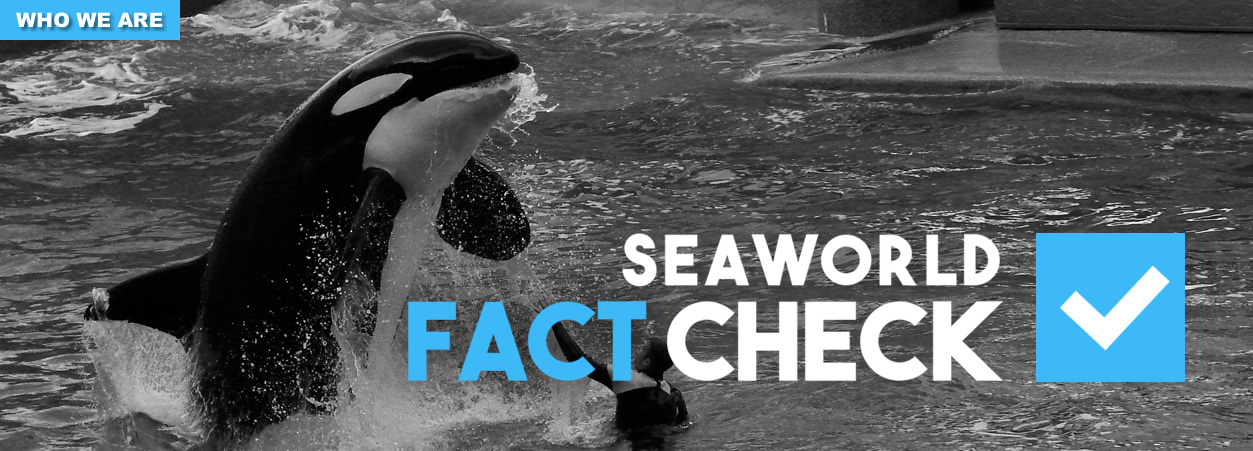SEAWORLD FACT CHECK:
In its reply, SeaWorld is essentially claiming that captive killer whale dentition is “normal.” This is incorrect.
From trainer and visitor observations, captive killer whales break and wear their teeth because they persistently grind them on the concrete walls and metal gates of their enclosures out of boredom or neurosis. However, there have been few peer-reviewed papers examining this common problem, because the facilities holding killer whales have published very little of substance on captive killer whale dentition. One paper (Graham and Dow 1990) describes one whale’s damaged dentition and the treatment for it. This paper clarified that the teeth of this one animal were worn by “biting a cement structure in the pool.” Indeed, the authors note that for whales in net pens, “there are no hard surfaces to chew on, so tooth wear is not evident after several years in captivity.”
Almost all captive killer whales suffer moderate to severe wear at the tip and occasional breakage (here are three random photos downloaded from the Internet):
|
Figure 1. There are several drilled out teeth, teeth worn to the gums, and broken teeth in these three photos. There are many more such photos available on the Internet. While less than a handful of juvenile to adult captive killer whales suffer no wear or breakage, this is the exception rather than the rule. These three photos are representative of most captive killer whale teeth. |
|
|
Killer whale teeth in the wild generally do not suffer severe wear at the tip (and only very rarely exhibit breakage) and when they do, this wear occurs at the population level and is associated with prey type (e.g., in the northeastern Pacific offshore ecotype, severe tooth wear is associated with feeding on sharks; Ford et al. 2011) or feeding method (e.g., in Type 1 North Atlantics, severe tooth wear is associated with suction-feeding; Foote et al. 2009). Pacific transient ecotype teeth show slight wear, associated with feeding on other marine mammals (Ford et al. 2011). Generally mammal eaters show wear on the sides of the tooth more than on the tip (Caldwell and Brown 1964). Northeastern Pacific resident and Type 2 North Atlantic teeth suffer no wear at the tip and only some on the sides (Ford et al. 2011; Foote et al. 2009). In all these papers, tooth wear is attributed to prey type or feeding method, not to general manipulation of objects in the environment.
Given that captive killer whale teeth rarely or never touch the fish they are fed (thawed frozen fish are dropped directly into the open mouths of the animals and are rarely handled by the animals’ teeth in any way), this begs the question of how their teeth wear or break like this. SeaWorld's response consists of two major points: 1) that moderate wear occurs when the whales’ teeth “brush against” abrasive surfaces such as the walls (the suggestion is that this happens only occasionally and even inadvertently and is more than a slight touch but far less than a concentrated grinding); and 2) that “a lot” of stranded killer whales have poor dentition, which is the result of simple “manipulation” of objects in their environment. This claim does not distinguish the populations from which such stranded whales come; it simply implies that many whales from all populations have teeth similar to those of captive killer whales and for similar reasons. This is incorrect.
References:
Caldwell, D.K. and Brown, D.H. 1964. Tooth wear as a correlate of described feeding behavior by the killer whale, with notes on a captive specimen. Bulletin So. Calif. Academy Science 63: 128-140
Ford, J.K.B., Ellis, G.M., Matkin, C.O., Wetklo, M.H., Barrett-Lennard, L.G., and Withler, R.E. 2011. Shark predation and tooth wear in a population of northeastern Pacific killer whales. Aquatic Biology 11: 213-224
Foote, A., Newton, J., Piertney, S.B., Willerslev, E. and Gilbert, M.T.P. 2009. Ecological, morphological and genetic divergence of sympatric North Atlantic killer whale populations. Molecular Ecology 18: 5207–5217
Graham, M.S. and Dow, P.R. 1990. Dental care for a captive killer whale (Orcinus orca). Zoo Biology 9: 325-330
_____________
SEAWORLD SAYS:
Killer whales, like all toothed whales and dolphins, develop worn teeth. It’s important to note that wild killer whales wear their teeth as well. And just like our killer whales, it’s a result of exploring and manipulating things in their environment.
Remember that killer whales, bottlenose dolphins, both species of toothed whales and dolphins, don’t have hands. They use their mouths to manipulate their environment. Looking at photos of stranded killer whales, you actually see that a lot of them have the exact same tooth profile as our killer whales. If they are exploring things in their environment or they’re brushing against a more abrasive surface, like a wall, there may be some tooth wear as a result.
The important difference is, of course, that we have a team of veterinarians there to intervene. If that were to develop into a problem and on the rare occasion that it does, we can step in and provide the comprehensive care that’s needed.
Interestingly, tooth wear is actually part of the latin species name of the bottlenose dolphin, tursiops truncatus. “Truncatus” is a reference to worn teeth. There is even fossil evidence of worn teeth in pre-historic cetaceans.*
* “Handbook of Marine Mammals, Volume 6”, ISBN 0-12-588506-7
|

